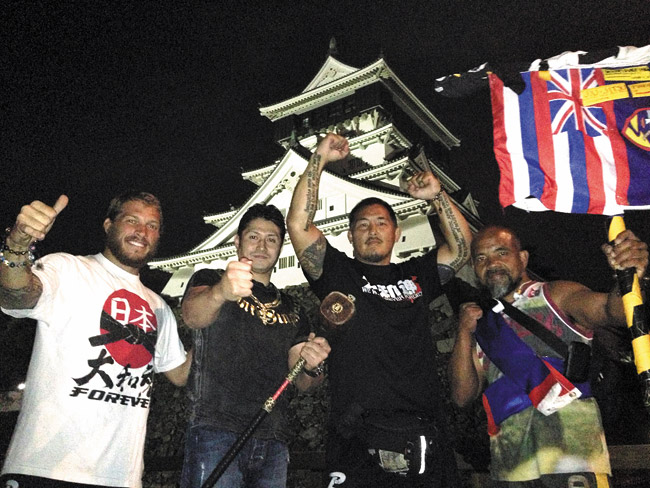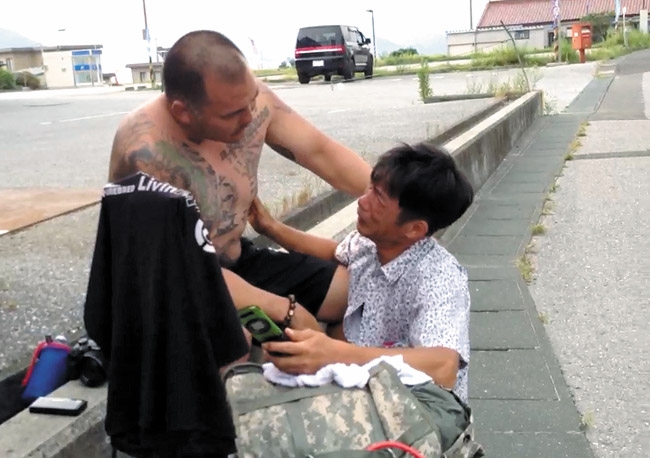Walking Japan For Tsunami Victims
Enson Inoue and Roman Dela Cruz walk more than 1,300 miles to raise awareness for the continuing plight of those hit by the Fukushima disaster
MMA champion Enson Inoue wanted to raise awareness of the people in the north of Japan who are still suffering since the 2011 earthquake and tsunami that reportedly left more than 15,000 people dead. So he decided to walk a long trek from the north to the south of the country.
mw-nm-010114-enson-010114-3
Along with friend Roman Dela Cruz, he started his epic journey Sept. 11 in Hokkaido and finished Nov. 16 in Kyushu, passing through some of the hardest-hit areas from the earthquake and tsunami, including Sendai and Fukushima. Another friend, Mike Fowler of North Shore Jiu Jitsu/Purebred Hawaii, joined them about halfway, in Tokyo, and walked with them to the end.
“If we didn’t get lost and went straight, it was 1,360 miles,” says Inoue, who was born and raised in Manoa and lives in Japan. “On the walk we had conditions: We had to do everything by foot, we only could eat or drink what we could carry and we couldn’t spend our own money on anything.
“I put those restrictions because we were walking for the people in the north, and they wouldn’t be surviving if it wasn’t for the people who gave them assistance and aid. So we were in a similar situation, where this journey could not be completed without help.”
Inoue also dedicated each day to a person, group or cause, such as on Day 9 to his dad Errol and mom Evangeline, with whom he would regularly check in.
“People would take us to restaurants and feed us full meals, or take us into their homes and put us up at night,” he recalls. “But there also were times we went without food. We also couldn’t spend money for sleeping quarters, so we were ready to bunk up anywhere – at bus stops, in stations, outside of bathrooms.
“We took showers where we could – in yards, parks, and there were a lot of times we couldn’t have any access, so we used body wipes. We really roughed it. There were times we slept on the street, straight on the sidewalk (in sleeping bags). I had three shirts and I would wash it every day with a bar of soap.”
Along the way, they were reminded of their purpose. Strangers would stop and talk, including one man who broke down in tears thanking them “for not forgetting.” Inoue has been up north 26 times since the tsunami, and says the area still needs help. It’s about a four-hour drive from where he lives in Saitama, and he plans to continue his mission trips at least once or twice a month, delivering rice and other supplies to families in temporary houses.
“It’s been forgotten because it’s not in the news anymore, even some people in Tokyo don’t know that people in the north are still not back on their feet and are still hurting,” he says. “The towns that were destroyed are still as is. People are still living in temporary houses, struggling to pay bills and put food on tables.
“They lost everything. Their whole lives they worked for – gone and disappeared into the air. And they feel like they’ve been forgotten.”
The walk also became an inspiration to the people there, motivating them to keep going despite any daily challenges they may face.
“I’d get goosebumps and it would warm my heart whenever there’d be a truck driving by, honking at us and telling us, ‘gambatte,’ which means ‘don’t give up,'” says Inoue. “The most inspiring thing about the trip was the people who came out to help us. It was incredible.”
Inoue, who lost 35 pounds by the end of the walk, adds that the experience also gave him a greater appreciation for things. “In life, there are three circles – things that irritate you, things that don’t matter and things that make you happy,” he explains. “What this trip helped do was it transferrered a lot of things in my circles into different areas. For example, things that irritate me, like traffic and people who cut in line, those things don’t irritate me anymore. And things that didn’t matter to me before, like having a roof to sleep under every night because I would drive home and go to sleep and not think nothing of it; now every time I lay in bed, there’s happiness. It’s something that makes me happy because I appreciate that I have somewhere to sleep. I appreciate that if it rains tonight, I’m not going to have to pack my things and move.”
Inoue also twice walked the famous 88-temple Shikoku pilgrimage, plus the 20 bangai temples around it, which totals about 880 miles. It took him about a month each time, and he did it for the challenge and to strengthen his heart.
“Thousands of people do (the Shikoku pilgrimage) every day, but few by foot,” he says. “You stop at every temple and make an offering and a prayer for health. I’m planning to do one every year.”
Inoue, 46, has been living in Japan since he was 23. He initially went there to play in a two-week racquetball tournament in place of his brother Egan. At the time, he had no plans to move to Japan, or even for the successful MMA career he would end up having there.
After the tournament, he was asked to run racquetball clinics throughout Japan, and during that time decided to extend his stay to learn to speak Japanese, so that he could find a better job in Hawaii. He also became the Japan representative for Egan’s racquetball company E-Force. One year turned into two, then three and after the fourth year, he was finally ready to return home to Hawaii.
That is, until one night when he went to watch MMA fighter Rickson Gracie fight. “I’m usually a real calm person. When I watch people play, I don’t scream out their name, I cheer inside and if anything, clap at the end of the match,” says Inoue, who was a student of Rickson’s brother Relson Gracie in Hawaii. “But what I found real interesting was when Rickson won his fight, I was out of control. I stood up screaming, and what intrigued me was that I wasn’t even the one in the ring. So this idea popped into my head that, if I can’t control my emotions watching my friend fight, it’s going to be a hell of a lot harder to control my emotions if I’m the one in the ring.
“So my whole idea to get into the ring wasn’t because I thought I could be a successful fighter. It was because I thought it was a good way to channel and practice the control of my emotions.”
That led Inoue to want to experience stepping into that ring once. He called around to different fighting organizations and found the Shooto association, which welcomed him to train and helped him get a fight in the ring. He won, and was quickly persuaded to enter one more fight, then two and three, and after the fourth one, the lightbulb lit and he realized, “I’m pretty good at this.”
That’s when he decided to stay in Japan to pursue fighting seriously. He became known as Yamato Damashii (or Samurai Spirit), and went on to have a fight record of 12 wins and eight losses, including fights in UFC and Pride FC.
He’s now retired from fighting but has gyms in Japan, Guam, Saipan, Thailand and affiliate gyms in Washington, San Diego and Canada under the name Purebred, that are operated by his students.
“I’ve realized fighting was a stepping stone to get to where I wanted to be in life, which is helping people,” says Inoue. “When I was fighting, it was my life, it was my career, I was willing to die for it. And over the years of maturity and experience, I’ve come to realize fighting was just a stepping stone to where I am today.
“I don’t feel any desire to fight anymore. I only do seminars because I believe MMA has given me what I have become, and I’d like to give back to MMA any chance I get. Now, I have more free time to do what my passion is, one that started as a hobby and has become a job: making bracelets with power stones.”
You read right: These days this tough champion fighter is busy making bracelets. His business is called Destiny Forever, and in Hawaii you can find him at Shirokiya making special appearances throughout the year. His next one is scheduled Jan. 16 through Feb. 2.
“In Japan, they believe if you wear one of these and it breaks, then it took something in place of you that was supposed to come to you,” he explains. “These bracelets will absorb that negativity and it will break. For me, it was a present from a friend, and what got me hooked on that idea of protection was that I totaled my S500 Mercedes Benz. I got a little bit of a swollen lip from the air bag, but no injuries. I walked away from it. I didn’t realize my bracelet broke until two days later, when I was sitting at home. I went back to the car dealer that towed my car, and we found the bracelet on the floor of the front seat.”
He asked his friend to teach him to make the bracelets, and he started making them for himself, then for friends and, as destiny would have it, people saw the bracelets on Facebook and wanted to buy them. “I told them it was just my hobby, but they kept insisting,” he says. “It came to a point where I had to open a homepage because my Face-book became a bracelet page, but it was supposed to be for my fans to follow me.
“I believe what you create in your life is going to be in your destiny, and your destiny is something that will stay with you forever.”







